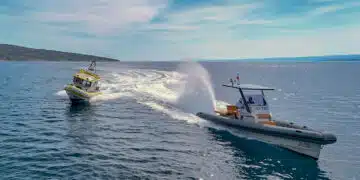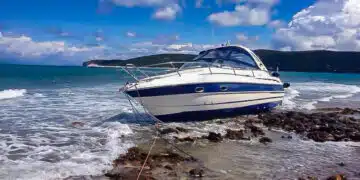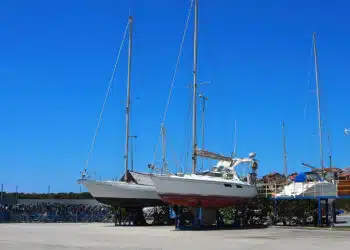Water ingress on board a yacht – in addition to fire on board – can quickly turn into a maritime emergency on a sea voyage. However, it is not always the spectacular collisions with containers floating just below the water’s surface that can lead to a leak. We show what should be done in the event of an emergency – and how you can best protect yourself against water ingress in advance.
Water ingress on board is an issue that concerns every recreational boater – and one that every sailor or motorboater has had to deal with at some point. It is not always the spectacular rammings with flotsam, other yachts or lost containers floating just below the water surface that can lead to holes in the ship. It is often the small, seemingly insignificant things on board that lead to water ingress on board.
For example, many water sports enthusiasts have forgotten to properly reattach the unscrewed leak plug before watering the dinghy – a lot of water can quickly accumulate on board, especially if a heavy outboard motor is attached to the stern and the dinghy is fully loaded. In most cases, the leak plugs are plugs that are threaded so that condensation or residual water can be easily removed from the inside of the boat or from the cockpit.
Small cause, big effect: the forgotten leak plug
Particularly in the case of trailer boats, which have to be lowered after slipping on and before road transport, the leak plug must be secured especially carefully to prevent it from being unintentionally unscrewed during a subsequent sea voyage. And while you are securing and checking the boat, you should also check the condition and function of the sea valves – this also often leads to uncontrolled water ingress. Winter storage after the imminent launch is a good opportunity for this.
According to an article on the 2yachts yacht platform, hull damage is generally defined by size (small, medium, large), by the nature of the openings in the hull (holes, cracks, loose seams or screws or rivets) and by the specific location in the hull (on the surface, underwater, directly at the waterline). This makes sense, as the measures to be taken to seal the leak as quickly as possible will ultimately depend on this.
Ship engines and their systems are the most common causes of water ingress
“If we exclude the effects of external objects, the ship’s engines and their systems are the most common internal causes of water ingress into the ship,” says SeaHelp operations manager Marko Orlic from the operations center in Punat. The experts at 2yachts also cite technical faults and physical wear and tear of units and parts on board as the most common reasons for leaks in boats.
These include, in particular, riveted and bolted connections, leakage of shaft or rubber seals, defective sea valves and damage or wear to hull passages below the waterline.
In the event of water ingress, appropriate measures should be taken immediately; the exact action to be taken depends on the individual case
If water is detected entering the boat while underway, measures should be taken immediately to prevent the ship from filling up further, advises SeaHelp operations manager Marko Orlic. What exactly should be done in each individual case depends on the type and size of the ship; unfortunately, there is no general approach.
A lot depends, for example, on when exactly it was discovered that water had entered the ship, says Orlic. He has already experienced situations in which sports skippers only noticed the water ingress when the engine or the engines on board no longer worked properly or even switched off by themselves; it was only during the subsequent inspection of the engine compartment that it was then possible to determine that the water was already at the level of the upper edge of the engine, says Orlic. In such situations, there is not much that can be done.
First the boat should be stopped and the engine switched off, then an intensive search for the leak should be carried out
“First of all, the boat should be stopped and the engine and gensets switched off if water is detected in the bilge or on the cabin floor,” says SeaHelp Managing Director Wolfgang Dauser. An intensive search for the leak should then be carried out. In his experience, simply switching off the engine can often prevent further water from entering the boat. “Cracked hoses or hose clamps that have become loose (corroded) are common causes”, and as long as the impeller pump (seawater cooling) is running, seawater is pumped into the engine compartment, says Dauser.
“Leaking shaft bearings, which used to be stuffing boxes that almost always dripped, are also very sensitive if the shafts are hit (for example by flotsam)”; cracked hoses or loose (corroded) hose clamps in the waste water and sewage system as well as anchor chain washing systems could also be the cause of water ingress, says Wolfgang Dauser.
It’s good if the boat has a bilge water alarm: water ingress can be detected early and tackled in good time
“If the boat has a bilge water alarm, water ingress can be detected relatively early”, adds Marko Orlic. Boat owners should then immediately try to identify the leak and repair the affected area or at least stop or reduce the water ingress.
Another tip from the emergency services professional: “If it is possible to sail towards the coast and run the ship aground in a controlled manner, don’t forget to reduce speed before running aground”; there have already been situations in which skippers have caused more damage by running aground than was caused by the water ingress.
Leaks that are just below the water surface can be “lifted out of the water” by heeling the ship
On the other hand, it can make sense – especially with sailing boats – to keep speed in the ship in order to achieve a certain lateral heel (in conjunction with appropriate crew trim), which can be used to “lift” the hole in the ship’s side upwind “above the waterline”.
The same applies to damage to the bow or stern of the yacht that is just below the waterline. These are easier to repair if the yacht’s trim is changed accordingly towards the front or rear. This can also be done by re-bunking cargo accordingly.
Leak plugs or leak stopper bags have proven effective for leaks on board
For smaller leaks, leak stoppers or so-called leak stopper bags have proven their worth. These are usually soft pieces of equipment such as cushions or pads that are carefully tied together or packed in a bag and can be pressed into a leak to stop the water ingress.
Wooden wedges can also be used as leak stoppers if, for example, a damaged sea cock needs to be sealed. There are also plastic leak stoppers available on the market, which are softly pressed into a hole, expand in the water and then harden. However, wooden wedges, which are usually made of pine wood, are just as suitable for preventing leaks; they can also be wrapped with cordage or canvas before being driven into the gap.
So-called leak sails can help to temporarily seal larger holes in the hull
If water penetrates through a lost rivet, you can try to seal the hole with a screw of the appropriate size. If no suitable screw or bolt is available, smaller wooden plugs can also help to seal the leak. Appropriately cut and wedged plywood sheets can help to seal damaged windows.
If there is a larger leak, making a so-called leak seal can help. In the original sense of the word, this is a sail (foresail or a piece of canvas) that is greased and pulled over a leak from the outside in the event of an accident. The main purpose of a leakage sail is to stop the ingress of water and to guide the boat so that sealing can begin on the inside.
A modern form of leakage sail is, for example, a special, stable umbrella that is pushed through a leak from the inside, then unfolded and tightened so that it can then be tightened to form a seal.
When taking over the charter yacht, seacocks and on-board outlets in particular should be checked for condition and tightness
Tip from the experts at 2yachts: Charter skippers should inspect the rental yacht very carefully before taking it over or before setting sail and pay attention to potentially dangerous areas of the yacht’s structure, in particular sea valves and on-board outlets should be checked for leaks, as should stuffing boxes in shaft systems.
In this way, many causes that could lead to a leakage on board can be ruled out in advance. SeaHelp head of operations Marko Orlic advises not only to carry the prescribed equipment and carry out regular, active maintenance of the ship, but also to install an alarm if the bilge water level is too high and to equip the boat or yacht with automatic pumps.
As a general rule: action should be taken quickly, deliberately and responsibly, and the entire crew must work together hand in hand
If the worst comes to the worst, quick, considered and responsible action by the skipper and good, swift cooperation between the crew will determine whether or not the trip turns into an emergency at sea.
If in doubt, however, one of SeaHelp’s rapid response boats should be called immediately in the event of uncontrollable water ingress – the professional, trained emergency crews have experience in dealing with leaks and how they can be sealed quickly and safely, and they know what to do if the water ingress cannot be stopped.
When making an emergency call (for example via the emergency call function of the SeaHelp app), information about the specific situation and the potential need for help should be provided immediately, advises SeaHelp operations manager Marko Orlic. If the ingress of water into the boat has been stopped or reduced, a new “all-clear” notification should be sent.
A sinking ship should only be abandoned if absolutely necessary
Important: “A sinking ship should only be abandoned if absolutely necessary”, advises Marko Orlic. In general, it should be borne in mind that a ship is easier for rescuers to spot in the open sea than rafts or rescue boats. Therefore, you should stay close to the yacht until the rescuers have arrived. And: if you don’t have a lifeboat, you shouldn’t get into the water too early to swim from the sinking ship, as there is a risk of hypothermia, says the rescue professional from SeaHelp.
A sailing yacht needs an average of 90 minutes from the time it enters the water until it submerges, adds SeaHelp Managing Director Wolfgang Dauser. For a motor yacht, the time to complete sinking is around 45 minutes, for a pleasure craft around 15 minutes. The reason for this is air pockets, which sometimes only escape very slowly from upholstery, bed mattresses, seat cushions, water and fuel tanks.
This proportion is lower for motor yachts and pleasure craft than for sailing yachts. In general, the following applies: “Don’t panic, you have enough time to react or at least take suitable measures to significantly delay the descent”, says Wolfgang Dauser.
In all other cases in which the water ingress of the yacht cannot be stopped, but it has not yet sunk, the SeaHelp emergency services will rescue the crew, ensure that the yacht is prevented from sinking and tow the yacht safely to the nearest port or marina, where the boat can be craned out of the water immediately so that the causes of the leak can be eliminated in peace.
24h EMERGENCY CALL EUROPE: 0043 50 43 112
In an emergency, SeaHelp’s rescue boats can be called using the practical SeaHelp app, or by calling the free emergency number for Europe 0043 50 43 112 (or the alternative emergency number for Europe 00385 919 112 112.
Download SeaHelp app:
* terminal or telecommunication service costs may apply


















